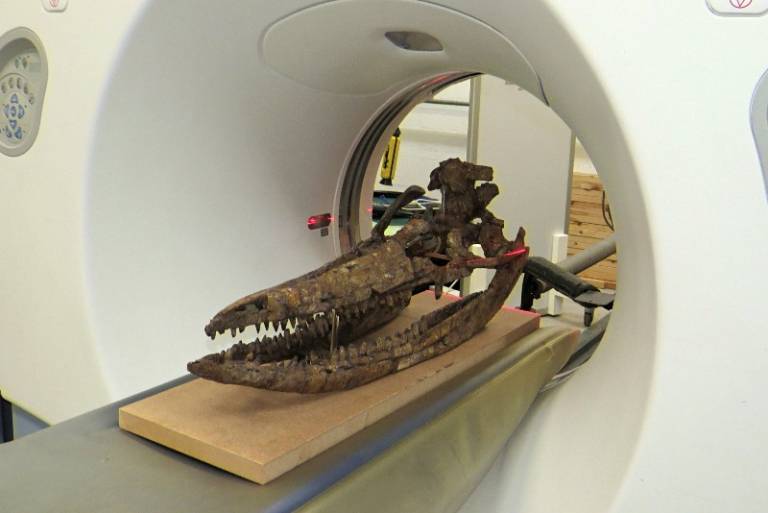Medical scanner helps unlock mysteries of rare ichthyosaur
8 January 2019
The skull of a giant fossil marine ichthyosaur unearthed more than 60 years ago has been studied for the first time, thanks to new research from a team including a UCL expert.

The research was conducted by palaeontologists Dean Lomax (University of Manchester) and Nigel Larkin (University of Cambridge), together with Dr Laura Porro (UCL Cell & Developmental Biology), as part of a project at Birmingham’s Thinktank Science Museum. The results, revealing new information about the marine monster, have been published in the journal PeerJ.
The almost 200 million year-old fossil, which was found in 1955 at Fell Mill Farm in Warwickshire, had never been formally studied prior to this research, but thanks to data collected from computerised tomography (CT) scanning, the research team were able to digitally reconstruct the entire skull in 3D. It is the first time a digital reconstruction of a skull of a large marine reptile has ever been made available for research purposes and to the public.
Although thousands of ichthyosaur fossils have been unearthed in the UK, this specimen is particularly important and unusual because it is three-dimensional and contains bones of the skull that are rarely preserved.
Dean, the lead author and one of the world’s leading ichthyosaur experts, said: “The first time I saw this specimen I was puzzled by its excellent preservation. Ichthyosaurs of this age (early Jurassic) are usually ‘pancaked’, meaning that they are squished so that the original structure of the skull is either not preserved or is distorted or damaged. So to have a skull and portions of the skeleton of an ichthyosaur of this age preserved in three dimensions, and without any surrounding rock obscuring it, is something quite special.”
The ichthyosaur was identified by Dean as a rare species called Protoichthyosaurus prostaxalis. With a skull almost twice as long as any other specimen of Protoichthyosaurus, this is the largest specimen of the species so far discovered. The skull was not quite complete, but several bones of the braincase – which are rarely preserved in ichthyosaurs – were present. To unlock information contained in the skull, these bones were micro-CT scanned at Cambridge University by expert palaeontologist and co-author, Dr Porro. Modern technologies, such as medical scanners, have revolutionised the way in which palaeontologists are able to study and describe fossils.
Dr Porro explained: “CT scanning allows us to look inside fossils – in this case, we could see long canals within the skull bones that originally contained blood vessels and nerves. Scans also revealed the curation history of the specimen since its discovery in the ‘50s. There were several areas reconstructed in plaster and clay, and one bone was so expertly modelled that only the scans revealed part of it was a fake. Finally there is the potential to digitally reconstruct the skull in 3D. This is hard (and risky) to do with the original, fragile and very heavy fossil bones; plus, we can now make the 3D reconstruction freely available to other scientists and for education.”
The fossil only preserved bones from the left side of the braincase; however, using CT scans these elements were digitally mirrored and 3D printed at life size to complete the braincase. Finally, the entire skull was CT scanned at the Royal Veterinary College using a scanner typically reserved for horses and other large animals.
Dean added: “It’s taken more than half a century for this ichthyosaur to be studied and described, but it has been worth the wait. Not only has our study revealed exciting information about the internal anatomy of the skull of this animal, but our findings will aid other palaeontologists in exploring its evolutionary relationship with other ichthyosaurs.”
The project was funded by PRISM fund, Arts Council England, The Dorothy and Edward Cadbury Trust, The Curry Fund of the Geologists’ Association and the Birmingham Museums Trust.
Links
- Dean Lomax
- Dr Laura Porro's academic profile
- UCL Cell & Developmental Biology
- University of Manchester
- Research published in Peer J
- Short Video & CT-scans
- Coverage
Image
CT-scanning of ichthyosaur skull at Royal Veterinary College, London (Credit: Nigel Larkin)
Media Contact
Colin Brook
Tel: +44 (0)20 3108 9046
Email: colin.brook [at] ucl.ac.uk
 Close
Close

